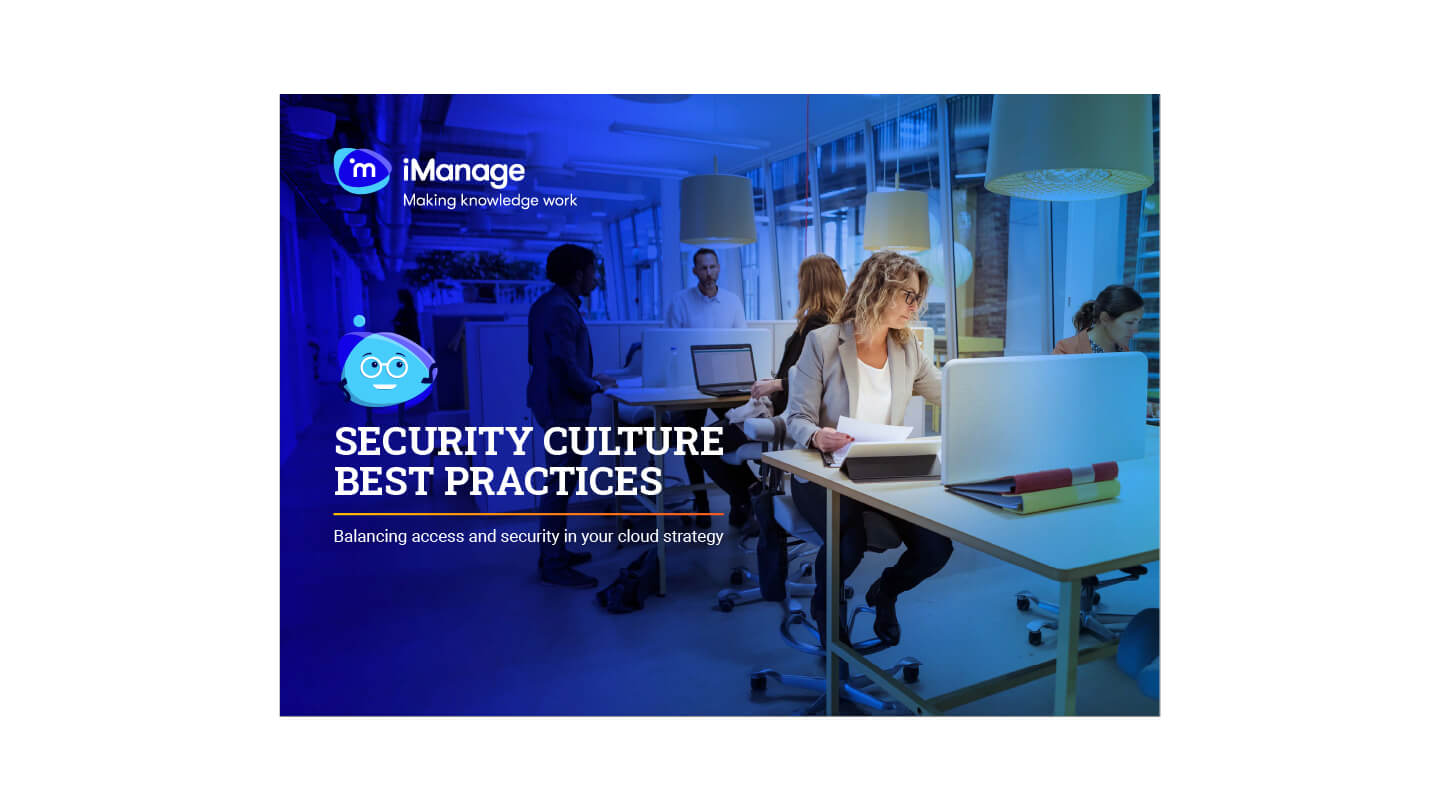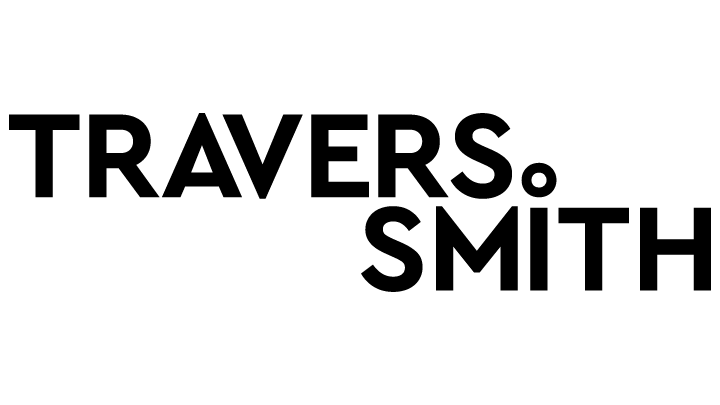Our mission is quite simply to make iManage the easiest and safest place to get knowledge work done.
And supporting that mission is the interconnected web of applications and services that comprise the iManage portfolio. We continuously enrich this portfolio with more powerful tools, features, and functionality to ensure our customers’ effectiveness and security as their requirements evolve in a modern workplace.
Always looking to the future, at iManage we are constantly working to enhance, develop and innovate. At our recent ConnectLive conference, we shared how we are investing our resources to focus on our mission in four key areas: deeper integration with the Microsoft ecosystem and Azure; increased user satisfaction and adoption; reduced friction between productivity and security to make work safer; and helping you grow your organization’s collective knowledge.

Seamless integrations
Integration should take place invisibly in the background so that users don’t even know it is happening, and that is our goal. We are continually enhancing the seamless integrations that we have been able to develop through our strategic relationship with Microsoft — including the integration of iManage applications with Microsoft 365, which most of our customers say is essential to their efficient performance of day-to-day work.
But we are also going beyond end-user apps to use the Microsoft platform much more extensively — to perform knowledge work automation, synchronous and asynchronous collaboration, and share contextual insights across platforms.

New experiences
Many innovations are due to come on stream over the next 12 months – and I’ll just mention three of them. The first is centralized audit services that help you get a lot more comprehensive information about what's going on in the system. You'll get a more holistic picture about more than just document audits, but also things that happen to users, things that happen to workspaces, folders, etc.
We're working to ensure that the service aggregates and consolidates audits across iManage products, and that’s going to power another set of technologies called webhooks. Webhooks enable you to put triggers in place on documents or other objects that can automatically kickstart a workflow when something changes (or “triggers”) it.

Increased usability
Adoption is a large topic and I’m unable to cover it all here, but I can point to some of the things iManage is doing to increase usability and ease-of-use of our applications – factors that ultimately work to increase adoption.
Successful firms grow, and with that growth comes increasingly large amounts of data to be managed and information to be found. Responding to various challenges people tell us they have in “finding their stuff,” we have been adding more search options in context, first to make our search options more obvious and second to improve the findability of the information you are searching for. We’re also making it easier for users to modify their searches without an administrator’s involvement, for example by adding their own fields to more closely tailor searches to their specific needs.
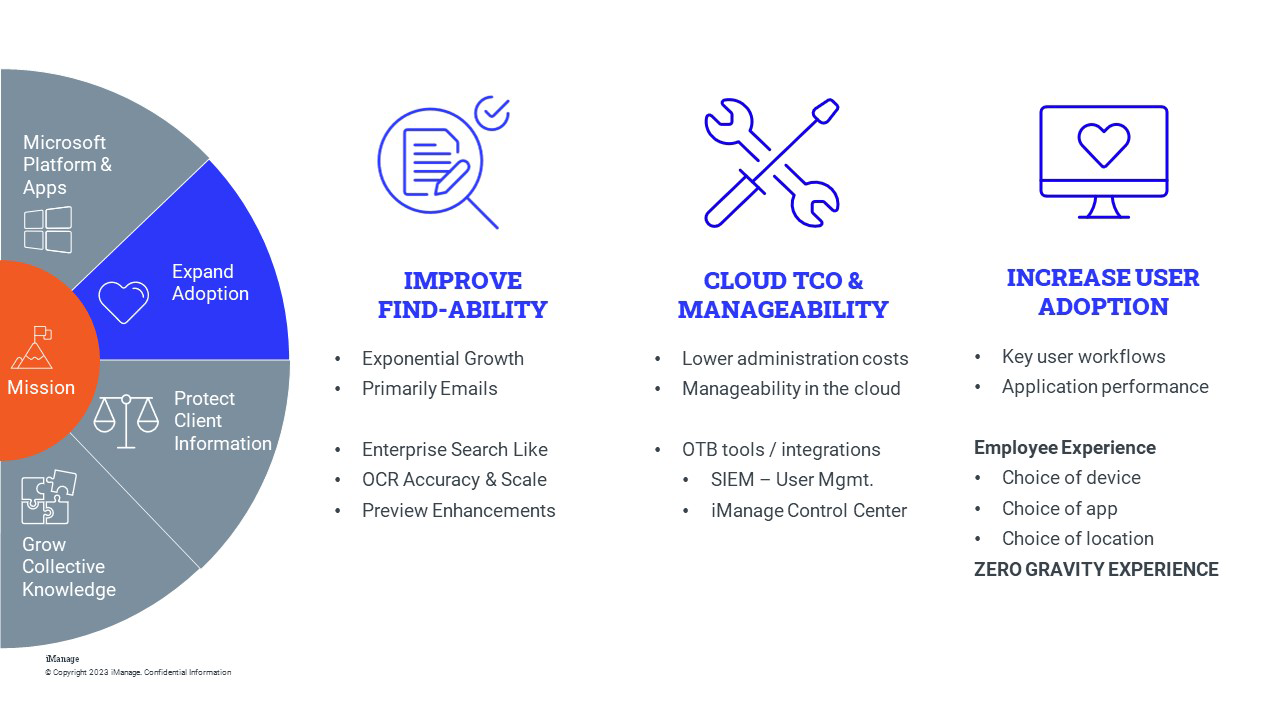
Greater portability
To enable you to be more productive and we’re eliminating extra steps and making it easier to work with iManage Drive. For example, you can now do a full-text search in Drive, you can keep all your engagements or matters in sync between iManage Work 10 and Drive, and you can also pull something into Drive straight from Work 10.
With the Zero Gravity experience, we have minimized the footprint we have on a user’s desktop or other device. This improves portability, increases cross-platform capability, and – the most important piece – which is reduced maintenance for your IT team.
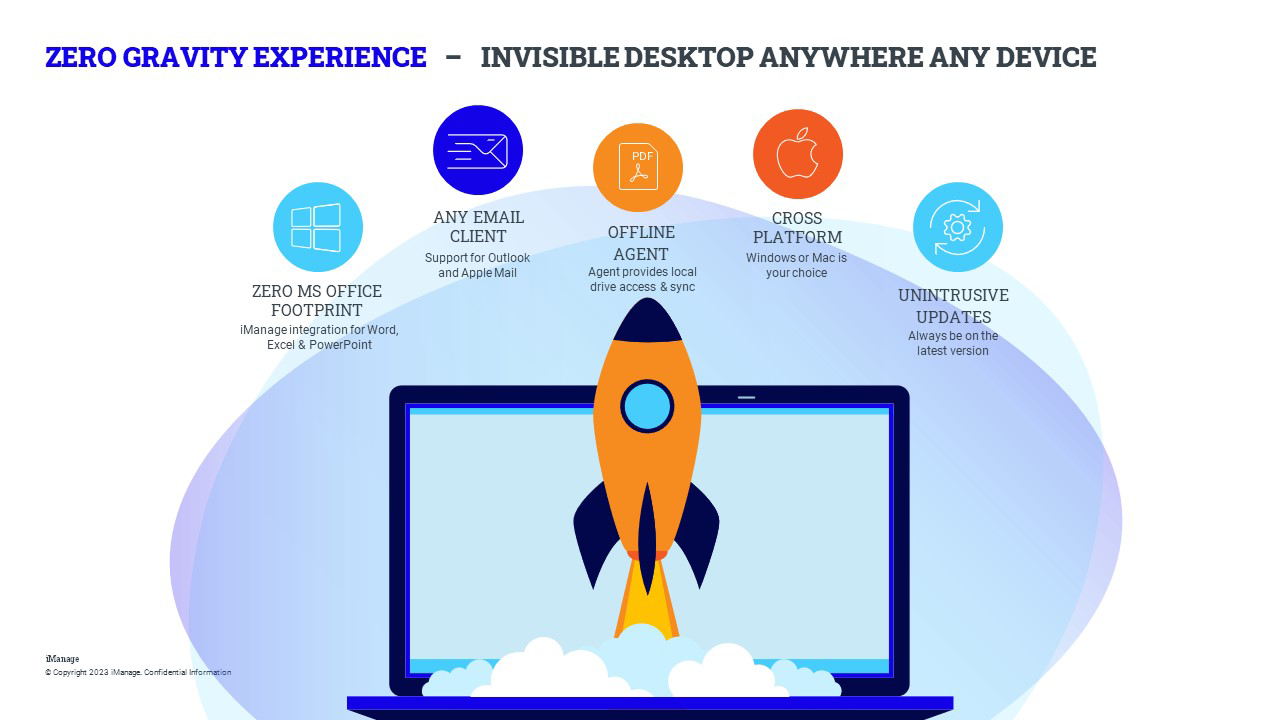
We’re also closely following and responding to developments in Office applications like Outlook to take advantage of changes happening there and ensure that iManage features are maturing along with the Microsoft products that you use every day.
Safer working, beginning to end
We recognize the tension that exists for our users between security and productivity, and we strive to ensure that our customers can protect their client information while using iManage — with minimal friction or disruption to the organization or user’s normal work practices.
We have iManage Security Policy Manager to enforce your policies and permissions, iManage Threat Manager to detect unusual behavior, provide usage analytics, and help you understand what’s going on behind the data, and iManage Records Manager to enforce governance policies consistently – including trigger events, retention periods, and disposition rules. We have tools to ensure the whole lifecycle of your engagements or matters. documents, emails, Teams conversations, and other information is handled safely from onboarding through the work itself, all the way to retention or destruction. And we’re modernizing Records Manager as we did with Work, making it cloud-friendly with a modern desktop and better workflows.
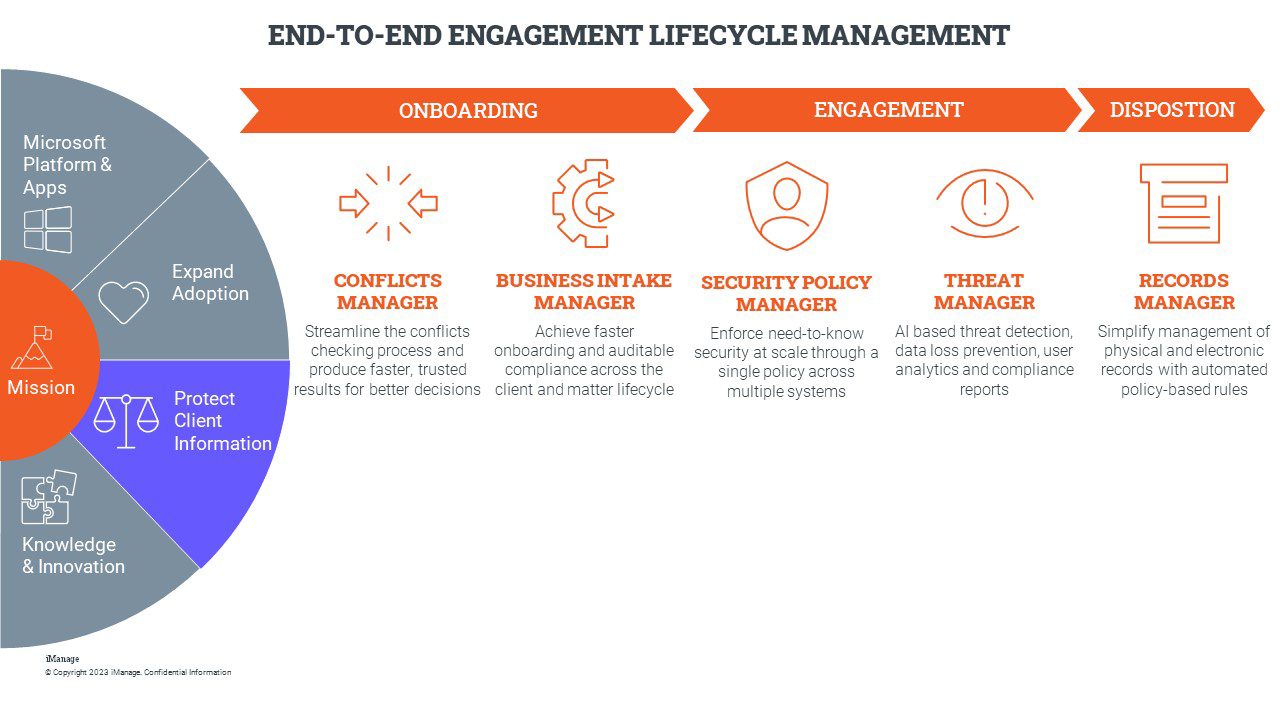
Over the next 12 months, you’ll see more ways to share information in iManage across departments, business units, or divisions, and even those who are not an employee but may need access, such as contractors. We are also looking closely at how you can exchange information across the firewall – and how self-governing documents could enable you to protect your confidential information that is obtained by a third party and unknowingly released into the ether.
Expanded metadata, curated knowledge
Over the next 12 to 18 months we plan to add more features to Insight+. New ways of querying data will put you in control of how your data is organized and how it can be searched and give you many different ways to slice and dice your curated knowledge — finding best practices or experts within a firm, for example. We even have plans to enrich the integration of our services with legal search providers, expanding metadata searching out to other cloud sources to enhance the quality and depth of the knowledge retrieved.
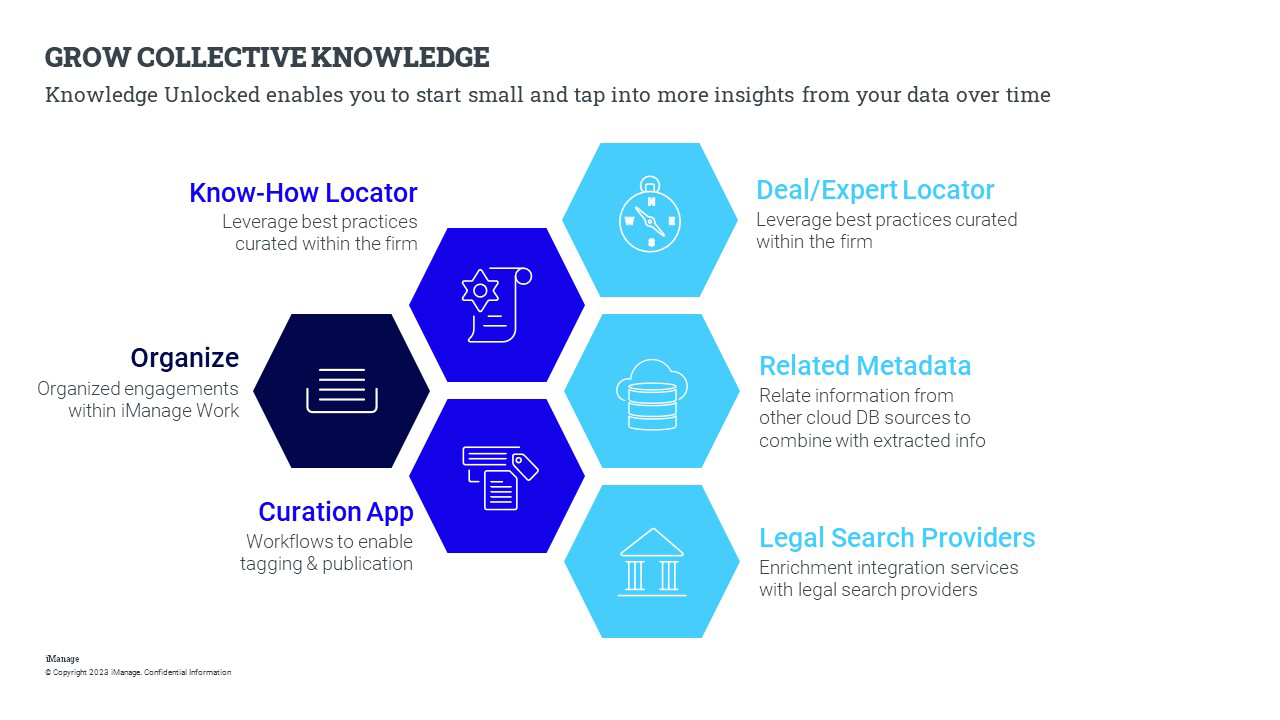
Building strength in depth – and always learning
There is so much more going on at iManage than I could go into here. I haven’t even touched on what the future of iManage looks like through the lens of generative AI and large language models (LLMs) and how transformational these will be for knowledge work in the future. So many questions beg to be answered, such as how will security work with LLMs? Which version is the version of truth? How do you guide AI to learn from the best of your data set?
This blog post just skims the surface of my ConnectLive keynote presentation. Look to the keynote and our other ConnectLive sessions for more detail on these and other topics of interest to our community. Click the link below to revisit the video or watch it for the first time and see the deck I presented. Talk to you again soon.



